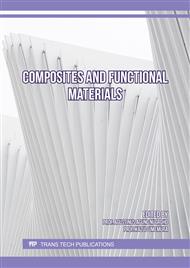[1]
B. N. Grgur, A. R. Elkais, M. M. Gvozdenović, S. Drmanić, T. L. Trišović, and B. Z. Jugović, "Corrosion of mild steel with composite polyaniline coatings using different formulations," Prog. Org. Coatings, vol. 79, no. C, (2015) p.17–24..
DOI: 10.1016/j.porgcoat.2014.10.013
Google Scholar
[2]
A. Zhu, H. Wang, S. Sun, and C. Zhang, "The synthesis and antistatic, anticorrosive properties of polyaniline composite coating," Prog. Org. Coatings, vol. 122, (2018) p.270–279.
DOI: 10.1016/j.porgcoat.2018.06.004
Google Scholar
[3]
M. Khodadadi Yazdi and G. Hashemi Motlagh, "Improved Electrical and Thermal Aging Properties of DBSA-Doped PANI Using MWCNT and GO," J. Electron. Mater., vol. 49, no. 9, (2020) p.5326–5334.
DOI: 10.1007/s11664-020-08256-x
Google Scholar
[4]
D. Zhao, X. Liu, Z. Li, and X. Bai, "Effect of emulsion polymerisation conditions on electrical performance of polyaniline," Pigment Resin Technol., vol. 40, no. 2, (2011) p.84–90.
DOI: 10.1108/03699421111113738
Google Scholar
[5]
Y. Kriswandono, M. Munaji, and T. Triwikantoro, "Electrical Conductivity of SDBS-Assisted Polyaniline Doped with HCl," Mater. Sci. Forum, vol. 1057 MSF, (2022) p.26–31.
DOI: 10.4028/p-6a9o69
Google Scholar
[6]
P. Sengupta, A. Bhattacharjee, and H. S. Maiti, "Zirconia: A Unique Multifunctional Ceramic Material," Trans. Indian Inst. Met., vol. 72, no. 8, (2019) p.1981–1998.
DOI: 10.1007/s12666-019-01742-9
Google Scholar
[7]
Musyarofah, N. D. Lestari, R. Nurlaila, N. F. Muwwaqor, Triwikantoro, and S. Pratapa, "Synthesis of high-purity zircon, zirconia, and silica nanopowders from local zircon sand," Ceram. Int., vol. 45, no. 6, (2018) p.6639–6647.
DOI: 10.1016/j.ceramint.2018.12.152
Google Scholar
[8]
T. Anwer, M. O. Ansari, and F. Mohammad, "Morphology and Thermal Stability of Electrically Conducting Nanocomposites Prepared by Sulfosalicylic Acid Micelles Assisted Polymerization of Aniline in Presence of ZrO2 Nanoparticles," Polym. - Plast. Technol. Eng., vol. 52, no. 5, (2013) p.472–477.
DOI: 10.1080/03602559.2012.757624
Google Scholar
[9]
G. K. Sidhu, N. Kumar, and R. Kumar, "Study the structural and optical behaviour of polyaniline/ZrO2 nanocomposites," in AIP Conference Proceedings, May 2018, vol. 1953.
DOI: 10.1063/1.5032555
Google Scholar
[10]
T. Anwer, M. O. Ansari, and F. Mohammad, "Dodecylbenzenesulfonic acid micelles assisted in situ preparation and enhanced thermoelectric performance of semiconducting polyaniline-zirconium oxide nanocomposites," J. Ind. Eng. Chem., vol. 19, no. 5, (2013) p.1653–1658.
DOI: 10.1016/j.jiec.2013.01.035
Google Scholar
[11]
F. C. P. Masim et al., "Synergistic effect of PANI–ZrO2 composite as antibacterial, anti-corrosion, and phosphate adsorbent material: synthesis, characterization and applications," Environ. Technol. (United Kingdom), vol. 40, no. 2, (2019) p.226–238.
DOI: 10.1080/09593330.2017.1385646
Google Scholar
[12]
N. Nadliriyah, A. L. Putri, and T. Triwikantoro, "PANi/ZrO2-composite coating for corrosion protection in 3.5 M NaCl solution," in IOP Conference Series: Materials Science and Engineering, Feb. 2019, vol. 496, no. 1.
DOI: 10.1088/1757-899x/496/1/012059
Google Scholar
[13]
H. Huang, Z. C. Guo, W. Zhu, and F. C. Li, "Preparation and characterization of conductive polyaniline/zirconia nanoparticles composites," in Advanced Materials Research, vol. 221, (2011) p.302–307.
DOI: 10.4028/www.scientific.net/amr.221.302
Google Scholar
[14]
C.O. Chikere, N. H. Faisal, P. Kong-Thoo-Lin, and C. Fernandez, "Interaction between amorphous zirconia nanoparticles and graphite: Electrochemical applications for gallic acid sensing using carbon paste electrodes in wine," Nanomaterials, vol. 10, no. 3, (2020) 537.
DOI: 10.3390/nano10030537
Google Scholar
[15]
B. P. Prasanna et al., "Synthesis of polyaniline/ZrO2 nanocomposites and their performance in AC conductivity and electrochemical supercapacitance," Bull. Mater. Sci., vol. 39, no. 3, (2016) p.667–675.
DOI: 10.1007/s12034-016-1196-9
Google Scholar
[16]
T. Velempini, E. Prabakaran, and K. Pillay, "Photocatalytic reductive applications of C-doped ZrO2/PANI composite towards Cr(VI)," J. Photochem. Photobiol. A Chem., vol. 426, no. June 2021, p.113737.
DOI: 10.1016/j.jphotochem.2021.113737
Google Scholar
[17]
M.O. Ansari and F. Mohammad, "Thermal stability, electrical conductivity and ammonia sensing studies on p-toluenesulfonic acid doped polyaniline:titanium dioxide (pTSA/Pani:TiO2) nanocomposites," Sensors Actuators, B Chem., vol. 157, no. 1, (2011) p.122–129.
DOI: 10.1016/j.snb.2011.03.036
Google Scholar



